In this 4th part of Climb Like A Girl, Mick Ryan focuses on a single controversial advertising campaign by the US outdoor clothing retailer Blurr and looks at how this campaign was received.
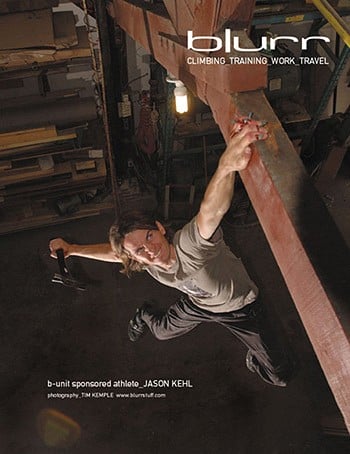
Blurr are a relatively new climbing apparel company based in Canada. They are to the East Coast what Prana are to the West Coast; the urban Yang to Prana's yoga-driven environmental-conscious Ying. The competition between Obe Carrion's hip-hop persona played against the Buddhist, Zen flute playing Chris Sharma. I first noticed Blurr when I saw their Jason Khel advert in a climbing magazine. Kehl's bloodied hand is nailed to a warehouse beam, with his other hand he wields an ice-axe. The nails bite deeper and rip into his flesh as he swings the axe. Marketing genius I thought, unlike anything I'd seen in a climbing advert before. The image perfectly sums up Kehl's public persona as an off-beat misfit into the dark arts, a modern Aleister Crowley, climbing's Marilyn Manson. It made me sit up and take notice.
Blurr soon followed up with more, not more of the same, they still tailored the images to the persona (real or imagined) of their sponsored athletes or B-Unit as they call them, but this time with a common theme, sex. The next four adverts used images that are unusual for climbing adverts as none of them featured climbers climbing but young hip celebrity climbers in an urban environment accompanied with all the accessories of modern urban living. Obe Carrion was portrayed as an urban ghetto-lord surveying his turf from a plush velvet sofa, antique Puma sneakers right in your face, brandy and cigar in hand. He the main man. Very New York. But where be his beatches? Nate Gold, pretty boy, second league climber, Sharma's fluff boy in the DVD Pilgrimage poses topless by the pool, definitely one for the girls. Very Miami. Draped over him, attentive to his every whim is a bikini-clad woman with pouting red lips, definitely one for the boys. Is she asking him how he would like his cocktail, or maybe pleading with him to leave his quiet thoughtful and philosophical reverie and "Please, please Nate take me to bed, I want you." No surprise that apparently the Biggie Smoothie has that effect in real life.
The Joe Kinder ad shows New Englands #3 climber in his familiar gangsta pose. The angry black white boy that he contrived in his interview in Urban Climber magazine, coveting Obe's authenticity, and dreaming of an escape from his middle-class mediocrity to the immediacy of the ghetto. In the background, secondary to the main man, are the accessories to his urban lifestyle, his ill-gotten gains and prized possessions, his sport car and his even faster and racier girlfriend in a mini-skirt, mid-rif bared, body in an open and submissive pose. No doubt who wants to be the master and who is the slave in this advert. Could be LA or Chicago.
The final advert was the most striking at least to me and the rest of the chromosome-missing crew. Every males fantasy, two lipstick lesbians getting it on. This is girl power in the raw. The third wave of feminism flaunting their sexual power in answer to the hairy-legged burn-your-bra radical feminism of the 1960s. Hot in every sense of the word. A drive the boys wild advert, whilst the girls know they are in charge. Definitely LA. Those legs just go on forever and where oh where is her hand going? This is what every (heterosexual) male climber needs after a hard day on the crag, sorry down the gym. That's it! I want a catalog and from now on I shall be adorned in Blurr gear.
These ads can be taken on several levels, they are a parody of images we are all familiar with and for those who can read the media maybe taken as tongue-in-cheek, ironic even. They still make me laugh after viewing them several times. On the other hand to the younger demographic who have been brought up on such images they are often taken very much at face value. But what have they got to do with climbing? I called Blurr marketing whizz, Gus Alexandropoulos. I could see where he was coming from, after all a new magazine, Urban Climber, that I discussed in From Across The Pond - November 2004 has heralded the emergence of a new demographic in climbing, the young urban climber who feels disconnected from how climbing is portrayed in the more established climbing media. I conveyed my mantra that surely the majority of climbers have always lived in the urban then escaped to the rural? What's different now?

"The urban demographic has always existed but I think that the outdoor industry has always been uncomfortable about admitting this reality. We are simply trying to be more honest. The emergence of indoor climbing, bouldering and even to an extent sport climbing have pushed the sport away from the purely adventure driven activity it may once have been and has now brought to the surface a user that views the sport like any other athletic endeavor. They don't see themselves as having to live on the poverty line so that they can pursue the sport. How many times have you read articles or seen ads promoting and championing the dirt bag lifestyle? For me this industry push just does not reflect who the real end user has become. I know of plenty of folks that hold down real jobs and climb hard. They are not "living in the dirt" they are pursuing their passion whilst owning homes, driving nice cars, eating good food, raising families and climbing at a high standard. For them it's not about either/or. They believe that you can have and enjoy the "trappings" of an urban environment, there's no need for escape, while at the same time enjoying what the outdoors has to offer. The best of both worlds.
OK, but what about the use of women in the ads to sell your clothing to a predominately male audience?
"The Joe Kinder ad? The concept here was to show these athletes in their fantasy urban personas. So working collaboratively we tried to get a feel for some imagery that would at some level reflect the personality of the athlete while at the same time creating imagery that forced climbers and the industry to reevaluate what climbers are supposed to really look like. The Nate Gold advert is a classic co-op of fashion magazine shoots. "Hello, I young, I'm beautiful and I'm ready to roll". Again an urban fantasy that most young male climbers would like to partake in.
Obe Carrion has a "larger than life" public persona we felt that we should go for a quieter image in this ad and let the photo and setting speak for themselves. You have picked up on all the classic cues we tried to insert – fine alcohol, cigars, plush velvet furniture, the shoes – all in a wonderful urban rooftop landscape. "Lord of all he surveys" is exactly what we were trying to do. Let's all sit back have a snifter of brandy, a fine cigar and contemplate the finer things in life. Ahhh the true climbing lifestyle!
With the Lisa Dumper advert we knew that we might get flack for this type of ad regardless of how we approached it so in the end we said "fuck it" and did what we wanted to do. In our opinion the outdoor industry seems to be stuck in some crazy second wave feminist/politically correct time warp. No one wants to acknowledge that the women climbing today are fit, attractive and for the most part very comfortable with the power of their sexuality. Many still believe that images of women climbing can't stray too far from the classic male image of the climber grimacing and hanging onto a tiny hold on the rock...Yawn."
And some women are quite happy with this approach especially the featured model.
"When we approached Lisa about this ad we discussed several options including her alone on the bike, her with some shirtless guy and finally, the "girl on girl" option. After she finished laughing she jumped at the chance to do ad and when she saw the proofs her first question was "can I get a print to show my parents?" For her, this was a great picture with interesting imagery and it did not devalue her climbing ability or current women's issues. Those gender battles had been fought, and in the mind of her generation, they had won. Why can't she look powerful and be sexy? What are female climbers supposed to look like? We all know how the two girl fantasy drives the boys crazy. Why can't she co-opt that powerful imagery for her own purposes. By the way, Lisa really is an incredible person. A super-talented climber in her mid twenties, she runs her own business and has purchased two homes. All self made. Not a bad female role model."
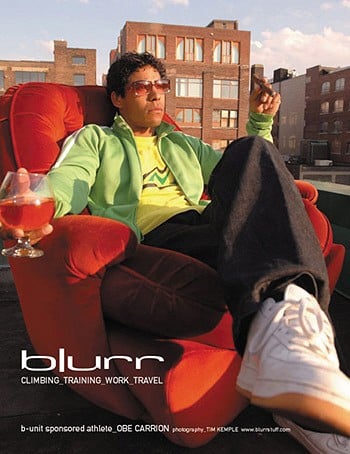
I asked Gus what kind of response the ads have got.
"Surprisingly positive! All the boys get it, or want to get it - no surprise. The women's reaction was a bit more complex. All the women we know that are in their mid twenties and younger loved the ad. However, we did get some resistance from women in their late thirties. I guess it gets broken down to generations and how they perceive feminism. The older generation having had to fight some of those classic battles was unsure of the ad where as younger female climbers that have grown up believing that there are no gender boundaries saw the ad as supporting a positive female gender notion – we climb, we are hot and we are in control."
I asked Lizzy Scully publisher of She Sends magazine what she thought of the Blurr adverts.
"They irritate me. Don't we see enough of his crap every day when reading magazines, watching TV and movies? I'm tired of it. They are demeaning to women by portraying them as sex objects. The people making these ads are juvenile. I don't think these ads are sexy at all. I think subtle exploitation of sexuality is fine and alluring in advertising or for whatever. Women are beautiful, and it's nice to celebrate beauty. For example, I loved the shot of Rikki Ishoy on the cover of Climbing magazine that caused so much controversy a few years ago. She was gorgeous and sexy in the bikini top, but she was strong and obviously a climber. The photo was natural. The Blurr ads have no taste. They remind me of pornography."
The kicker though is would Lizzy accept the Blurr ads in She Sends?
"Since I'm not running the magazine anymore I can't really say. I think it would be a tough decision because we always need more advertising, and it's a bad idea to burn bridges in our very small climbing community. On the other hand, I'd be ashamed to have a Blurr advert in She Sends. As everyone knows I'm not very comfortable with compromising my beliefs, so no."
Lizzy passed me over to the current editor-in-chief of She Sends, Kasey Cordell.
"Lizzy articulates my perspective well. I think Gus is great, a total sweetie. The Blurr ads might have a place in Climbing and Rock and Ice. I mean, they are certainly effective – look how much people talk about them. But if our mission at She Sends is to promote women and community I'm not sure how the ads, in their current form, would fit. I wouldn't want to see them in She Sends simply because, as Lizzy says, they're about being sexy for men. I like feeling sexy as much as the next girl, so I don't think "sexy" ads per se are out of place in She Sends, but it needs to be in the context of empowering women, not playing into male fantasies. If Blurr wanted to submit some new creative that still worked for them and meshed with our perspective, then I'd be psyched. Perhaps a nearly naked man or something, making men objects for a change."
Perhaps I should have asked if Gus had come knocking on their door with $2,000 and the Lisa Dumper advert, would they have run it? I failed to see what Gus being a sweetie had to do with anything, perhaps they were trying to let him off lightly.
At the Outdoor Retailer trade show last January the Blurr team caused quite a stir with their clothing, the images and the considerable buzz. Gus Alexandropoulos, Blurr's marketing director again,
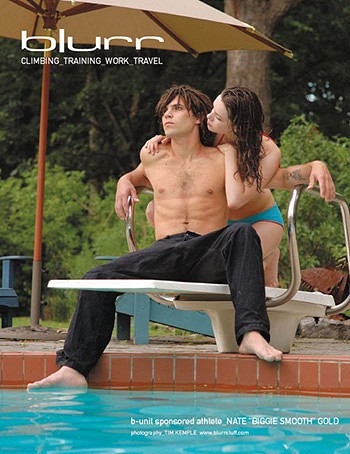
" Lizzie Asher approached us at our trade booth, sat down and emphatically stated that she wanted to be a part of the "b-unit". Lizzie will be 19 this March and finished first in the bouldering and second in the route climbing competitions during the North American Championships held this past November in Mexico City. When I asked her why she wanted to be a part of the team her response was, as she waved a hand at all the ads, "because of all this – it speaks to me" She went on to say that some of the other brands make great stuff but it does not reflect her lifestyle, I am paraphrasing. She definitely felt that the ads and the Blurr brand spoke to her.
But what is it in the Blurr ads that speak to Lizzie Asher?
Does she want to be the moll of a misogynistic ghetto lord or hip-hop DJ who in popular culture has used and abused women? You know what they say, "once you've tasted black you won't go back." Does she you want to be a Playboy bunny fulfilling the every whim Hugh Heffner figure by a swimming pool? Or perhaps to be part of the ultimate male sexual fantasy, the threesome with two bisexual girls. Everyone can be famous these days so the media tells us? Is it this celebrity aspect and all its trappings that attracts her? Maybe she wants to appear in a Blurr ad similar to the Lisa Dumper advert, strong, in control, successful but at the same time tantalizing the boys with her sexuality. Maybe she just wants sponsoring so she can go climbing more?
Something else speaks to Lizzie Asher, something just as strong. In an article in the LA Times in May 2004 by Shermakaye Bass, Asher said about climbing. "I like those days when you get up early....because you are out there to climb and nothing else matters. You don't even think about what you are going to eat for dinner or what you packed for lunch. You just stay out all day, from when the park opens till when it closes at sunset."
As Gus says, "the best of both worlds", the trappings of a successful urban life and the means to play outside at any opportunity. That has and will always be the dream of every climber surely?
But there is something else, perhaps a little more sinister, that speaks to Lizzie Asher, something that perhaps she isn't aware of. Both male and female climbers under 25 have grown-up with sexualized images of women. They accept them as normal. Kids are getting older younger, this has an acronym, KAGOY that was coined by marketers, it also has another marketing term, "age compression" where marketing messages and products originally designed for adolescents and young adults are targeted to younger kids. In Born to Buy, an analysis of modern marketing to teens, tweenies (7 to 12 year olds) and younger children the author Juliet B. Schor recounts a story of a third grade teacher (8 year olds) who asked her class what they knew about Mexico, six or seven hands were raised, "That's the place where MTV's Spring Break takes place!". For those who haven't seen it, the program glorifies heavy partying, "bootylicious girls, erotic dancing, wet T-shirt contests, and binge drinking. Abercrombie and Finch (a youth clothing retailer) came under fire recently for selling thong underwear to seven to fourteen year olds. The World Wrestling Federation sells action figures recommended for ages four and above that include a male character with lipstick on his crotch. Then there's the Britney Spears bare midriff factor that speaks very loudly to young girls. Whilst girls have always enjoyed dressing up like mommy, it does get a little worrying when you get four year olds grinding their hips like Britney Spears, when the isles of department stores are filled with off-the shoulder t-shirts and low-slung jeans that are tailored to fit three year olds.
Modern marketing think tanks and their closet-peeping research methods purposely expose kids to fashion, glamour, style, irony and popular music in every aspect of their young lives, from cereal boxes to teen magazines like Seventeen which is read by one in every two of American female teens. Studies have shown that many of the images in Seventeen, as well as being sexualized, show women in subordinate poses, a bashful knee bend and a lowering of the chin, similar to the girl in the Nate Gold Blurr advert. Then put a man in a position of power, indifferent to all but his preoccupation with his own personal material well being and sexual pleasure – with a girl trying to attract his attention, and you have a summation of at least two of the Blurr adverts, women subordinate to men, a clear message that the female body is a sexual object, a concept of femininity that is behind the times even in the hazy theory of girl power feminism. Yes of course the Blurr ads spoke to Lizzie Asher, just as modern marketing techniques and social trends spoke to Blurr. Self-destructive consumerism in a world of dwindling resources and exploding populations is on a march and central to the selling and creating the desire is our age-old friend, sex.
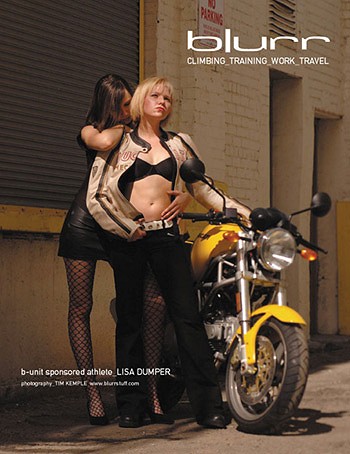
The Blurr ad campaign may be excused as tongue in cheek or given the label a post-90's irony attention-getter, but it is also a series of shock ads that subjugate women and that goes against everything that is happening in climbing as regards women these days. Of course that was not the intention of Blurr. Just like many young people who are exposed to modern marketing techniques, a type of brainwashing, they are an unwitting victim and Gus Alexandropoulos, who is very bright as well as being a "total sweetie", admits that he does have complex thoughts about the issues that these adverts raise. On the upside of course the ads have worked. It's got the chattering classes chatting, me writing this, you reading this, many comments both in private and in public, viral marketing at its best. You won't forget Blurr anytime soon. Such is the power of the image. Images can inspire, motivate, make you cry, fill you with nostalgia, they are used as tools of propaganda by corrupt governments, both democratic and by dictators. The image can also can become commonplace and after a while lose its effect. Whilst the Blurr adverts may seem odd in a climbing context there overuse will lessen their impact and then what? In a desperate grab for attention will the next climbing company in the increasingly competitive market try to reflect all the ten year olds cranking V10 by submitting an advert displaying pre-pubescent girl climbers sticking their tongues out, jumping on a bed dressed in school girl socks, wearing a short skirt and pony tails. Surely the climbing magazines wouldn't accept an ad like that, or would they?
Whilst I was writing this article I went to see the Vagina Monologues at Skidmore College in Saratoga Springs, upstate New York. Skidmore is a liberal arts college that used to be all-women college. It has a women' studies department and unisex bathrooms, is very active in the study and raising the awareness of women's rights on a global scale. The theater where we watched the students perform Eve Enslers's award winning play that celebrates women's sexuality and strength, was small and cozy. The Virginia Monologues brings all three of the feminist waves together, the early suffragette movement, the radicalism and the legislative action of the 1960s and the Girl Power of the early 21st C all crash together in one big tidal wave of ideas. It was quite an experience watching such an intimate play in such intimate surroundings surrounded by an audience that was predominantly female and young. I put the average age at around 20, that includes the audience, the performers, the directors, and the theater staff.
Using all the courage I could muster I approached a group of twenty-something girls, showed them the Blurr ads and told them what I was doing, and asked them what they thought of them. Yes, Nate Gold is hot, but the overwhelming response was one of confusion and surprise as to why an outdoor company would use such images. Mary Reynolds, a 20 year old from Kansas picked up on the Kinder and Gold ads, and used words such as 'exploitive', 'demeaning' and 'misogynistic'. The Dumper ads drew a more mixed response. Maybe the split in attitudes to Gus Alexandropoulos' ad campaign isn't so much to do with age but more what you are exposed to? If you understand what women have gone through, and what many are experiencing right now, your attitude may be different than of a woman who is ignorant of that.
Women have ambiguous and contradictory feelings about how women are portrayed in the media. What woman does not want to look attractive and admired? But at the same time does a woman want to be known for how she dresses, how much flesh she reveals, and how physically attractive she is above everything else. It's no coincidence that food eating disorders like anorexia and bulemia are on the rise. Cosmetic surgery in the US is main stream, breast implants now have FDA approval. Some women spend thousands to reach some notion of womanhood marketed to them, but many who don't feel they have reached this idealized state suffer from lack of self-esteem and depression. And the poor boys, they all want to marry a super model. Maybe it's all hard-wired, maybe it's not?
The question I ask is this. Does this type of marketing, and maybe exploitation, have a place in your climbing world, a climbing world which for many is distraction from the toxic waste dump of tabloid and cable news, a relief from the inescapable noise of intrusive and saturated marketing, and yes, an escape from the trials and tribulations of every day 21st century life?
[advert()]











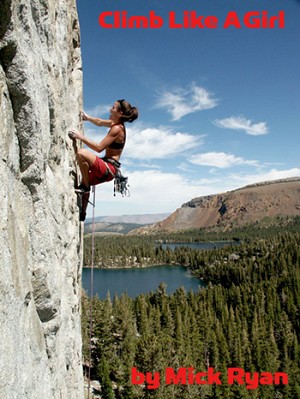
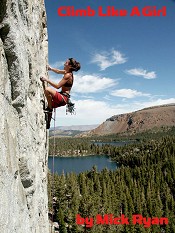
Comments